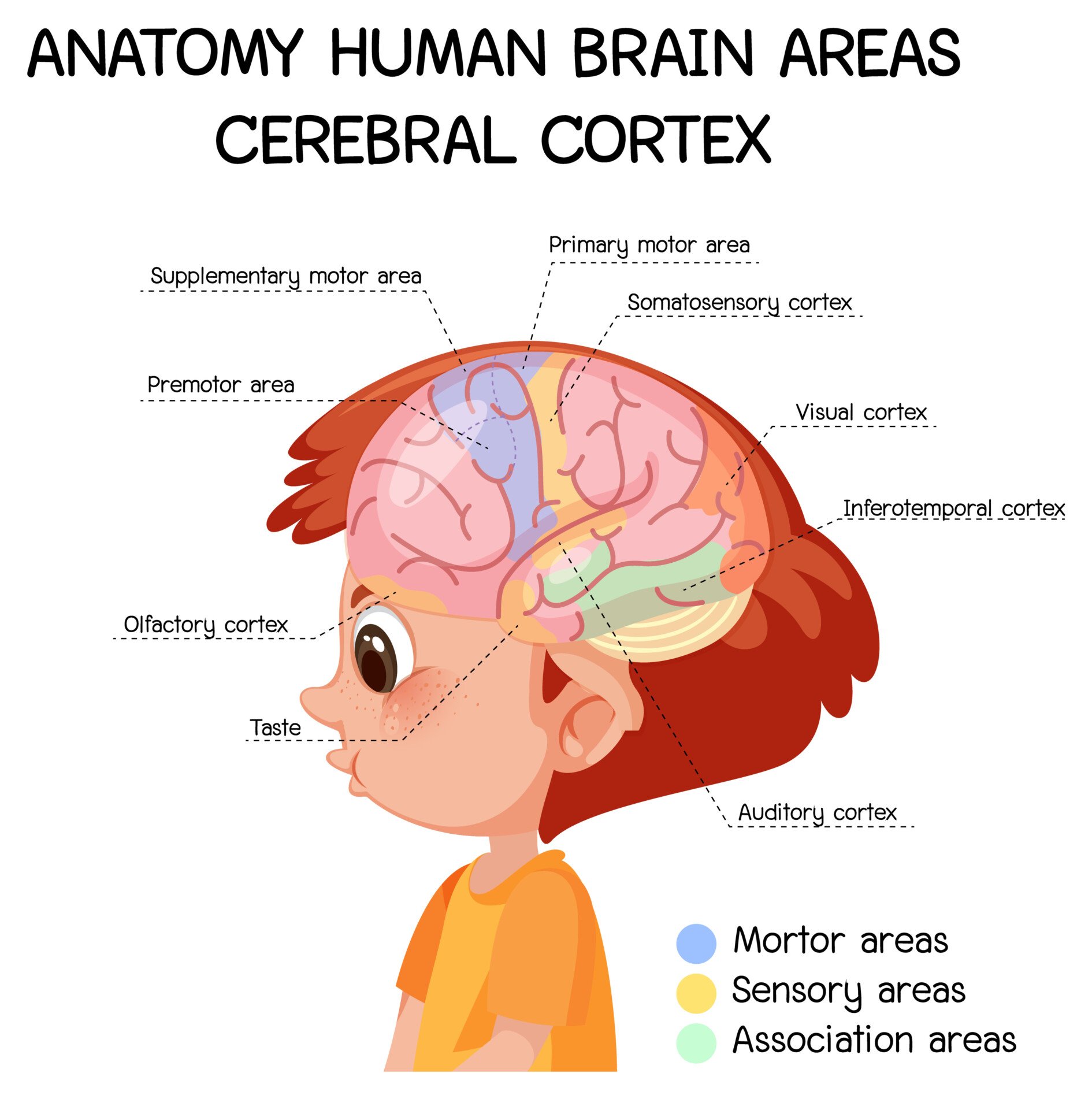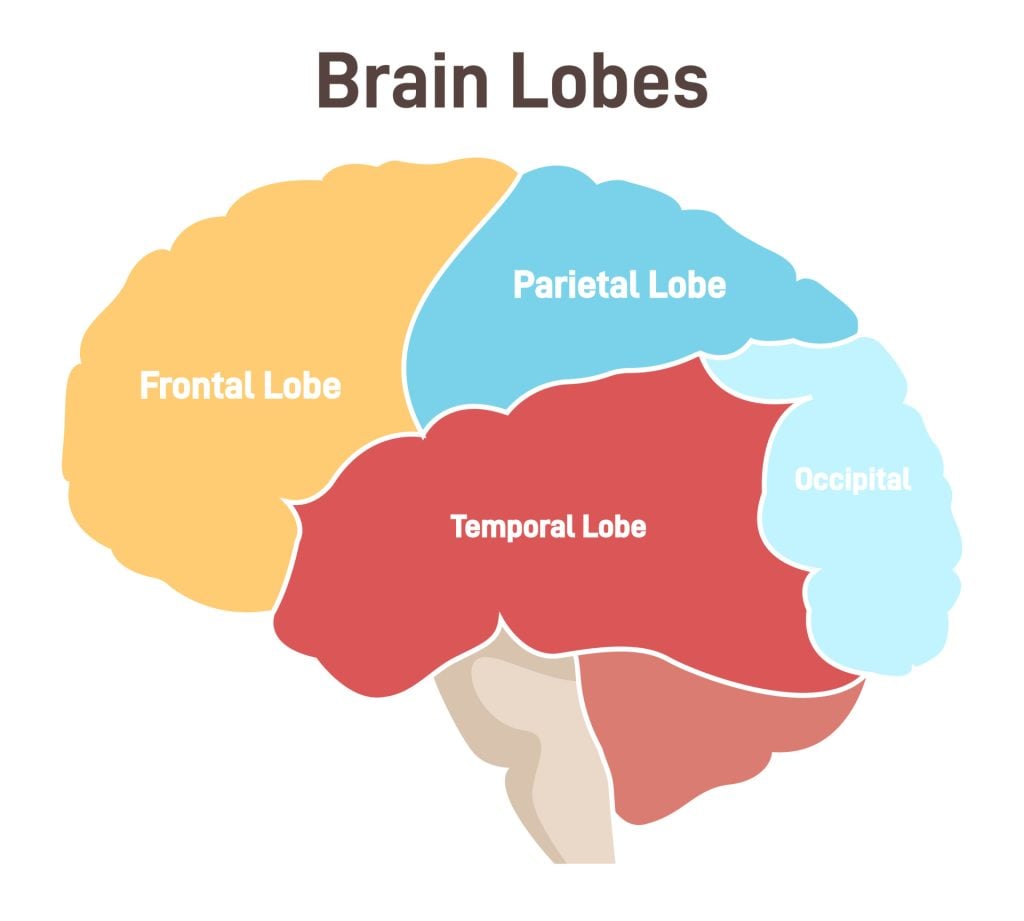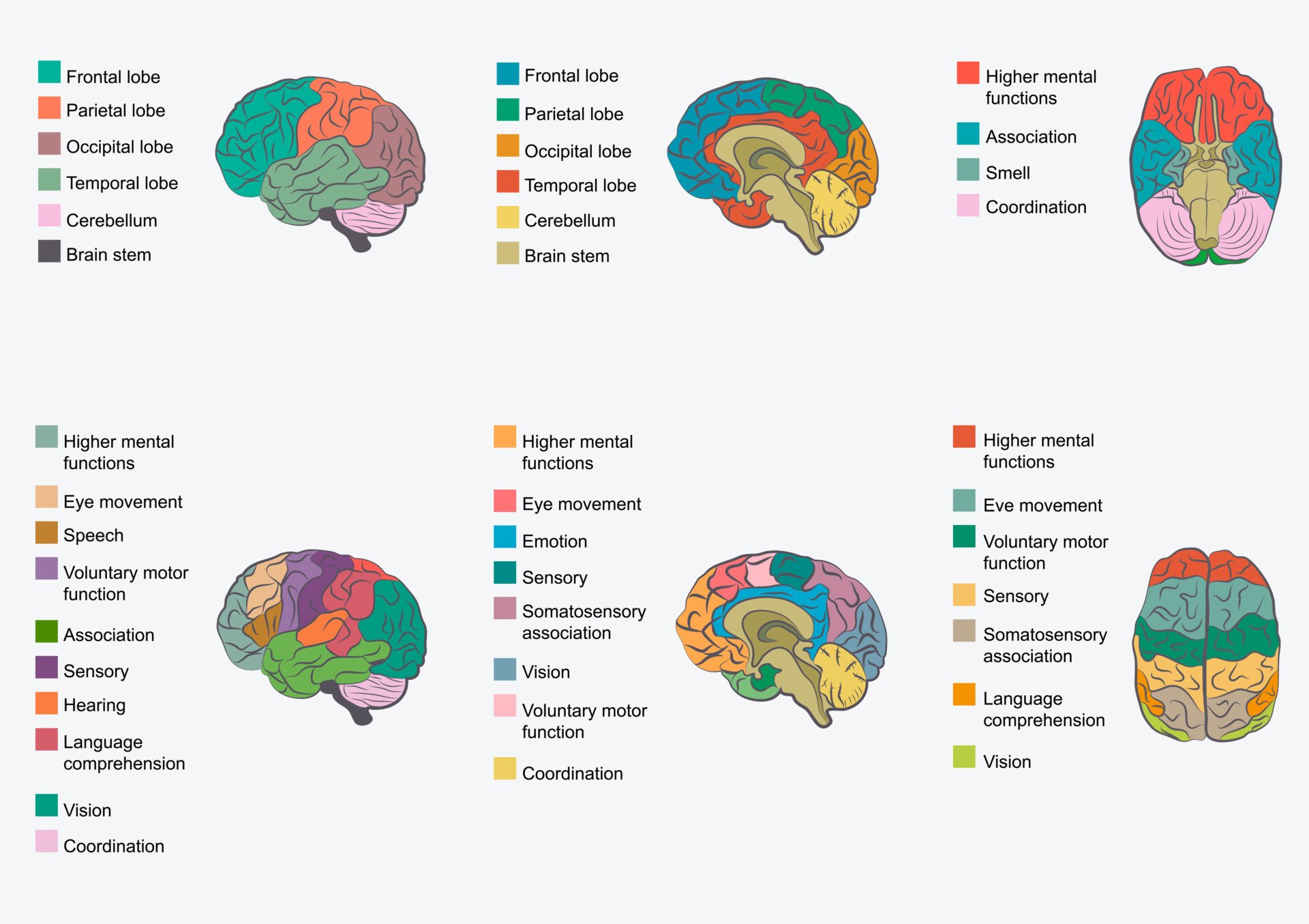On This Page:
In psychology, the cerebral cortex is defined as the outermost layer of the brain, composed of folded gray matter, playing a crucial role in various complex cognitive processes. It is responsible for functions like thought, perception, language, memory, attention, consciousness, and advanced motor functions.

The cerebral cortex is the brain’s outermost layer on top of the cerebrum and is associated with our highest mental capabilities.
The cerebral cortex is primarily constructed of grey matter (neural tissue made up of neurons), with between 14 and 16 billion neurons found here.
Although the cerebral cortex is only a few millimeters thick, it consists of approximately half the weight of the total brain mass. The cerebral cortex has a wrinkled appearance, consisting of bulges, also known as gyri, and deep furrows, known as sulci.
The many folds and wrinkles of the cerebral cortex allow for a wider surface area for an increased number of neurons to live there, permitting large amounts of information to be processed.
The cortex is also divided into two hemispheres, the right and left, which are separated by a large sulcus called the medial longitudinal fissure.
The two hemispheres are connected via bundles of nerve fibers called the corpus callosum to allow both hemispheres of the cerebral cortex to communicate and make further connections.
The cerebral cortex controls a vast array of functions through the use of the lobes, which are divided based on the location of gyri and sulci. These lobes are called the frontal lobes, temporal lobes, parietal lobes, and occipital lobes.
Structure
The cerebral cortex has a layered structure, with 6 layers numbered from the outer surface (Layer 1) to the innermost layer (Layer 6).
- Layer 1 is the molecular layer, containing few neuronal cell bodies but many dendrites and axons.
- Layer 2 is the external granular layer, containing small pyramidal neurons and numerous small granule cells.
- Layer 3 is the external pyramidal layer, with predominantly small and medium pyramidal neurons.
- Layer 4 is the internal granular layer, with mainly stellate and pyramidal neurons.
- Layer 5 is the internal pyramidal layer, containing large pyramidal neurons that give rise to major output pathways.
- Layer 6 is the multiform layer, with few large pyramidal neurons among many smaller types.
The cerebral cortex can be divided into 3 main regions:
- Neocortex: The evolutionarily newest part, with 6 layers. Makes up about 90% of the human cerebral cortex. Responsible for higher cognitive functions like sensory perception, generation of motor commands, spatial reasoning, language, and conscious thought.
- Allocortex: The older part with fewer than 6 layers. Includes the olfactory cortex and hippocampus. Plays a role in olfaction and memory.
- Archicortex: The oldest part with only 3 cortical layers. Forms the hippocampus. Involved in memory and spatial navigation.
The cortex also contains many different types of neurons and neuroglial cells that support cortical function:
- Pyramidal cells: The primary projection neurons shaped like pyramids. Located in layers 3, 5, and 6. Transmit signals from one region of the cortex to another.
- Stellate cells: Found in layer 4. Receive and integrate inputs from the thalamus.
- Basket cells: Inhibitory interneurons found in layers 2-6. Help regulate cortical excitability.
- Astrocytes: Star-shaped glial cells that provide structural and metabolic support to neurons. Help regulate neurotransmitter levels.
- Oligodendrocytes: Produce myelin to insulate neuron axons, speeding up signal transmission.
- Microglia: Act as the immune cells of the brain, responding to pathogens and brain injuries.
Cerebral Cortex Function
The cerebral cortex, which is the outer surface of the brain, is associated with higher level processes such as consciousness, thought, emotion, reasoning, language, and memory.
Each cerebral hemisphere can be subdivided into four lobes, each associated with different functions.
Together, the lobes serve many conscious and unconscious functions, such as being responsible for movement, processing sensory information from the senses, processing language, intelligence, and personality.

Frontal Lobes
The frontal lobes are the largest part of the cerebral cortex, located at the front of the brain behind the forehead.
The frontal lobes are highly developed in humans and critical for many higher-order cognitive functions.
Specific regions and functions of the frontal lobe include:
- Prefrontal cortex: Involved in planning complex cognitive behaviors, personality expression, decision-making, and moderating social behavior.
- Primary motor cortex: Located in the precentral gyrus. Initiates voluntary movements and contains a motor homunculus. Damage can cause contralateral paralysis.
- Premotor cortex: Plays a role in the selection and control of voluntary motor movements, especially learned sequences of movements. Damage can cause issues with coordinated motor planning.
- Frontal eye fields: Guide eye movement and visual attention.
- Broca’s area: Critical for speech production and language expression. Located in the left inferior frontal gyrus. Damage causes expressive aphasia.
- Dorsolateral prefrontal cortex: Involved in working memory, executive function, and attention regulation. Damage impairs cognition.
- Orbitofrontal cortex: Plays a key role in decision-making, impulse control, and socially appropriate behaviors.
The frontal lobes are highly interconnected with other cortical and subcortical regions, including the limbic system. They are critically involved in higher cognitive functions, executive control, emotional regulation, and social cognition.
Damage can cause personality changes, impaired judgment, memory loss, and reduced motor control and language expression, depending on the specific region affected.
Occipital Lobes
The occipital lobes are located at the very back of the brain. This region processes visual information received from the eyes.
The main functions of the occipital lobes include:
- Vision – The primary visual cortex in the occipital lobe interprets visual signals from the retinas of the eyes. This area handles basic visual functions like perceiving color, motion, and shape.
- Recognition – Additional visual association areas help identify objects, faces, words, and scenes that you see.
- Imagery – The occipital lobes contribute to visual imagery and picturing images in your mind.
- Communication – This region connects with other parts of the brain to integrate visual perceptions with memories, sounds, and more.
Damage to the occipital lobes can cause issues like blindness, difficulty recognizing objects or words, and problems with visual processing. Overall, this area is essential for interpreting visual stimuli.
Parietal Lobes
The parietal lobes are located near the top of the brain behind the frontal lobes. This area integrates sensory information from different parts of the body.
Key functions of the parietal lobes include:
- Touch – The primary somatosensory cortex receives information about touch, temperature, pain, and the body’s position.
- Integration – It combines input from the senses to represent the body and its location in space.
- Motion – The parietal lobes guide actions and movements in response to sensory stimuli.
- Attention – It plays a role in selective attention and focusing on relevant stimuli.
- Spatial orientation – This region helps construct a sensory map of the environment and understand spatial relationships.
Injury to the parietal lobes can cause issues with coordinating movement, directing attention, and processing sensory information from the body and surroundings. Overall, it integrates sensory signals to guide behavior.
Temporal Lobes
The temporal lobes are located on the sides of the brain above the ears. This part of the brain helps with processing sounds, understanding language, forming memories, and regulating emotions.
The main roles of the temporal lobes include:
- Hearing – The temporal lobes receive auditory information from the ears and help interpret sounds and words. A small area called the primary auditory cortex processes the basic aspects of hearing.
- Memory – An important structure called the hippocampus is located in the temporal lobes. The hippocampus helps form new memories about events, facts, places, and experiences.
- Language – A region called Wernicke’s area in the left temporal lobe is important for understanding spoken and written language.
- Emotion – The amygdala, found deep in the temporal lobes, regulates emotions like fear, anger, and aggression. It also links memories to emotional reactions.
The temporal lobes work with other parts of the brain to help us recognize words, speak, form memories of life events, perceive emotional cues, and understand language.
Damage to this area can cause issues with hearing, memory, emotions, or comprehending language.
In summary, the temporal lobes are involved in sound processing, memory, emotional control, and language functions.
They allow us to understand speech, form memories, regulate moods, and interpret auditory stimuli. Damage can disrupt these important abilities.
Areas of the Cerebral Cortex
The cerebral cortex can be characterized as being made up of three types of divisions, which serve different purposes: sensory, motor, and association areas.

The combination of these three areas accounts for most of human cognition and behavior.
Sensory Areas
The sensory areas of the cerebral cortex receive sensory information from the senses and environmental stimuli. This information is also processed by the sensory areas to give meaning to this information.
The sensory areas include the visual cortex, the somatosensory cortex, the auditory cortex, and the gustatory cortex. The visual cortex is an area within the occipital lobes that is essential to the conscious processing of visual stimuli.
There are two visual cortices in the brain: the cortex in the left hemisphere receives signals from the right visual field, whereas the cortex in the right hemisphere receives signals from the left visual field.
The visual cortex is important for making sense of visual information and plays a role in object recognition and representation.
The somatosensory cortex is located within the parietal lobe and receives tactile information from the body. This information can include temperature, touch, and pain, all of which are then integrated into the somatosensory cortex to produce a ‘map’ of the body.
The auditory cortex is an area within the temporal lobes which is responsible for processing auditory information. This cortex can perform basic and higher functions relating to hearing, including the ability for some people to language switch.
Finally, the gustatory cortex is a region in the frontal lobe that is responsible for the perception of taste and flavor.
Motor Areas
The motor areas of the cerebral cortex are involved in the regulation and initiation of voluntary movement. These areas are primarily found within the frontal lobes and include the primary motor cortex, premotor cortex, and the supplementary cortex.
The primary motor cortex is associated with the coordination and initiation of motor movements. Each cerebral hemisphere of the primary motor cortex contains a motor-related representation of the opposite side of the body.
There is also a representational map of the body with the primary motor cortex, called a motor homunculus. The premotor cortex is involved in preparing and executing limb movements, as well as using information from other regions of the cortex to select appropriate movements.
The premotor cortex is also necessary for learning, especially through imitation and social cognition, specifically empathy.
The supplementary cortex is responsible for the planning of complex movements and contributes to the control of movement.
Association Areas
The association areas are spread throughout the cerebral cortex in the four lobes. These areas act by integrating information from these brain regions, often adding more complexity to their functions.
These association areas can also form connections to sensory and motor areas to give meaning to and organize information in these areas. Association areas within the frontal lobes are involved in key processes such as planning, thinking, and feeling.
These areas also play a role in personality and controlling emotional behaviors. Association areas within the parietal lobe are involved in spatial skills such as spatial awareness and reasoning, as well as being responsible for paying attention to visual stimuli in the environment.
In the temporal lobes, association areas function primarily in memory processes, such as helping to process procedural and episodic memories.
These areas also communicate with other lobes of the cortex so they can complete memory-related processes.
Occipital lobe association areas help to facilitate memories associated with visuals to be retained, as well as enable us to think in a visual manner.
These areas in the occipital lobes also communicate with other lobes of the cortex to assimilate visual information with memories, sounds, and language to understand visual stimuli.
Brodmann Areas
Brodmann Areas, named after German neurologist Korbinian Brodmann, are a system for mapping and categorizing regions of the human cerebral cortex based on their distinct cellular architecture and functions.
These numbered areas, which range from 1 to 52, provide a structural framework for understanding different brain functions, such as sensory processing, motor control, and higher cognitive processes, contributing to our knowledge of brain organization and function.
Clinical relevance
- A literature review investigated the frontal lobe’s association with schizophrenia and found that many patients had differences in grey matter volumes and functional activity in their frontal lobes compared to those without the disorder (Mubarik & Tohid, 2016), suggesting that the frontal lobes are associated with this disorder.
- It has been found that there was reduced grey matter volume of the parietal lobes in those diagnosed with schizophrenia (Zhou et al., 2007). This suggests that structural abnormalities or atrophy in the parietal lobes may contribute to some of the symptoms of schizophrenia, implying that treatments targeting this brain region could potentially help manage the disorder.
- Children with ADHD showed altered functional connectivity and reduced network efficiency in the frontal and occipital lobes when viewing facial emotions, indicating differences in emotional processing compared to neurotypical children (Nasab et al., 2021).
- Researchers found that impairments with attention within the temporal lobes are associated with developmental dyslexia (Voldois et al., 2019).
- A review of brain imaging studies found differences in the development of frontal lobe volume in children with autism spectrum disorder compared to typically developing children. Frontal lobe volume was greater between ages 2-4 years in autistic children, suggesting altered brain development in regions important for cognitive skills (Crucitti et al., 2022).
- It has also been suggested that early signs of Alzheimer’s disease may be noticed within the temporal lobes (Lowndes & Savage, 2007).
- A brain imaging study found people with depression had differences in the temporal lobe, including less volume and surface area compared to healthy individuals. Connections between the temporal lobe and visual processing areas were also reduced in depression. These differences may act as biomarkers to identify depression (Zhang et al., 2023).
References
Crucitti, J., Hyde, C., Enticott, P., & Stokes, M. (2022). A systematic review of frontal lobe volume in autism spectrum disorder revealing distinct trajectories.
FlintRehab. (2021, January 11). Cerebral Cortex Damage: Definition, Symptoms, and Recovery . https://www.flintrehab.com/cerebral-cortex-damage/#:~:text=Parietal%20Lobe%20Damage,problems%20with%20sensation%20and%20perception.
Huang, J. (2020, September). Brain Dysfunction by Location. MSD Manual . https://www.msdmanuals.com/en-gb/home/brain,-spinal-cord,-and-nerve-disorders/brain-dysfunction/brain-dysfunction-by-location
Lowndes, G., & Savage, G. (2007). Early detection of memory impairment in Alzheimer’s disease: a neurocognitive perspective on assessment. Neuropsychology Review, 17 (3), 193-202.
Mubarik, A., & Tohid, H. (2016). Frontal lobe alterations in schizophrenia: a review. Trends in Psychiatry and Psychotherapy, 38(4), 198-206.
Nasab, A. S., Panahi, S., Ghassemi, F., Jafari, S., Rajagopal, K., Ghosh, D., & Perc, M. (2021). Functional neuronal networks reveal emotional processing differences in children with ADHD. Cognitive Neurodynamics, 1-10.
Onitsuka, T., McCarley, R. W., Kuroki, N., Dickey, C. C., Kubicki, M., Demeo, S. S., Frumin, M., Kikinis, R., Jolesz, F. A. & Shenton, M. E. (2007). Occipital lobe gray matter volume in male patients with chronic schizophrenia: A quantitative MRI study. Schizophrenia Research, 92 (1-3), 197-206.
Valdois, S., Lassus-Sangosse, D., Lallier, M., Moreaud, O., & Pisella, L. (2019). What bilateral damage of the superior parietal lobes tells us about visual attention disorders in developmental dyslexia. Neuropsychologia, 130, 78-91.
Zhang, S., She, S., Qiu, Y., Li, Z., Wu, X., Hu, H., … & Wu, H. (2023). Multi-modal MRI measures reveal sensory abnormalities in major depressive disorder patients: A surface-based study. NeuroImage: Clinical, 39, 103468.
Zhou, S. Y., Suzuki, M., Takahashi, T., Hagino, H., Kawasaki, Y., Matsui, M., Seto, H. & Kurachi, M. (2007). Parietal lobe volume deficits in schizophrenia spectrum disorders. Schizophrenia Research, 89 (1-3), 35-48.

